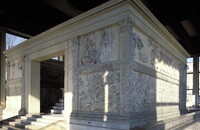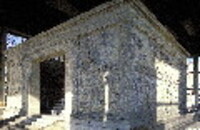| dc.coverage.spatial | Site: Rome, Lazio, Italy | en_US |
| dc.coverage.temporal | 13-9 BCE (creation); 1938 (restoration) | en_US |
| dc.creator | unknown (Roman (ancient)) | en_US |
| dc.date | -13--9 | en_US |
| dc.date.accessioned | 2013-05-29T18:59:30Z | |
| dc.date.available | 2013-05-29T18:59:30Z | |
| dc.date.issued | -13--9 | en_US |
| dc.identifier | 221982 | en_US |
| dc.identifier.other | archrefid: 500 | en_US |
| dc.identifier.uri | http://hdl.handle.net/1721.3/129931 | |
| dc.description | View depicting the west front and the south elevation; Dedicated on 30 January 9 BCE, the altar was erected in the Campus Martius by the Roman Senate to commemorate Augustus' return from Spain and Gaul on 4 July 13 BCE. The best-known exemplar of Augustan art, it is typified by its eclectic mix of Classical and Hellenistic elements and skillful amalgam of Roman myth-history and contemporary events. Source: Grove Art Online; http://www.oxfordartonline.com/ (accessed 9/1/2009) | en_US |
| dc.format.medium | marble | en_US |
| dc.rights | © Scott Gilchrist, Archivision, Inc. | en_US |
| dc.subject | allegorical | en_US |
| dc.subject | mythology (Classical) | en_US |
| dc.subject | portraits | en_US |
| dc.subject | rulers and leaders | en_US |
| dc.subject | Augustus, Emperor of Rome, 63 B.C.-14 A.D. | en_US |
| dc.subject | Julio-Claudian dynasty | en_US |
| dc.subject | Imperial (Roman) | en_US |
| dc.title | Ara Pacis Augustae | en_US |
| dc.title.alternative | Altar of Augustan Peace | en_US |
| dc.title.alternative | Ara Pacis | en_US |
| dc.type | image | en_US |
| dc.rights.access | Licensed for educational and research use by the MIT community only | en_US |
| dc.identifier.vendorcode | 1A3-R-R-AP-1-A3 | en_US |
| vra.culturalContext | Ancient Roman | en_US |
| vra.technique | construction (assembling) carving (processes) | en_US |
| vra.worktype | monument | en_US |
| vra.worktype | relief (sculpture) | en_US |
| dc.contributor.display | unknown (Roman (ancient)) | en_US |


